Intel Dual-Core Mobile Ivy Bridge Launch and i5-3427U Ultrabook Review
by Jarred Walton on May 31, 2012 12:01 AM EST- Posted in
- Laptops
- CPUs
- Intel
- Ivy Bridge
- Ultrabook
Ivy Bridge Ultrabook Gaming Performance
Okay, enough of the theoretical 3DMarks results. Let’s see how well ULV Ivy Bridge and HD 4000 can do in our gaming suite. (If you don’t care at all about gaming, just skip this page and move on.) I’ve only included the Value charts below, but I’ll summarize some additional gaming test results after the graphics. As always, if you want to know how we test games (or other applications) on laptops, please see our 2012 Mobile Benchmark Matrix.
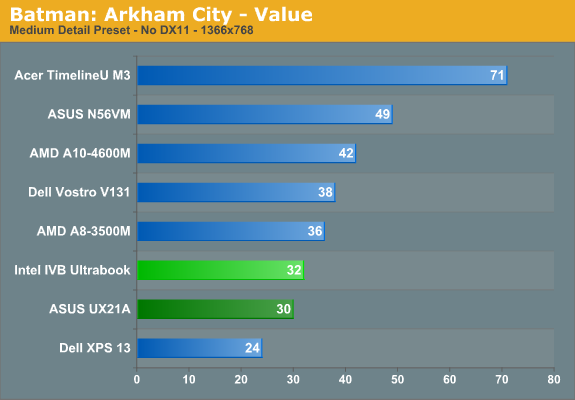
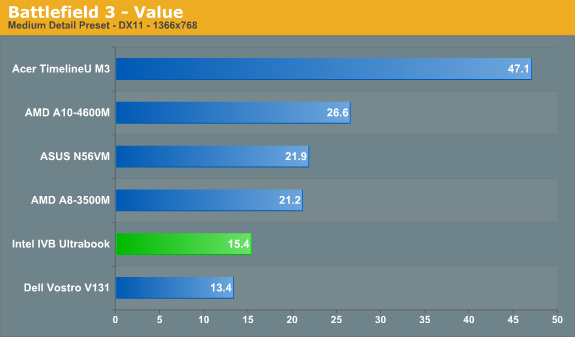
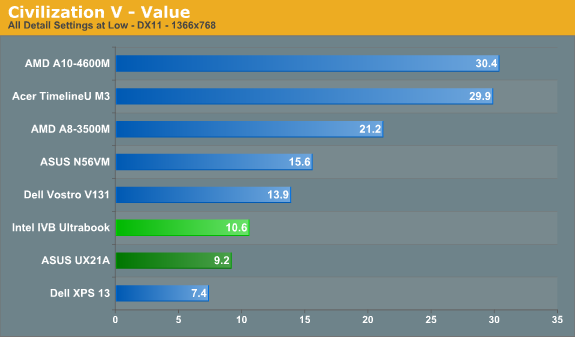
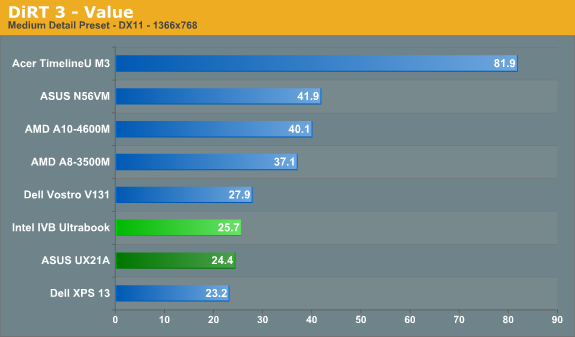
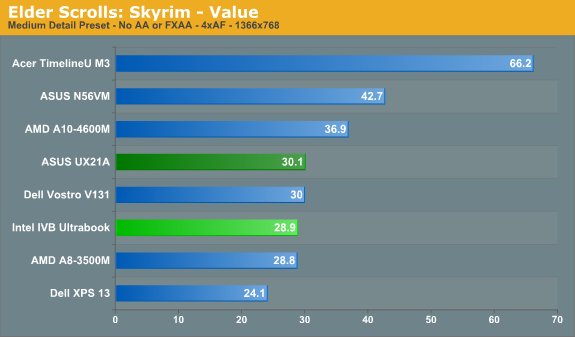
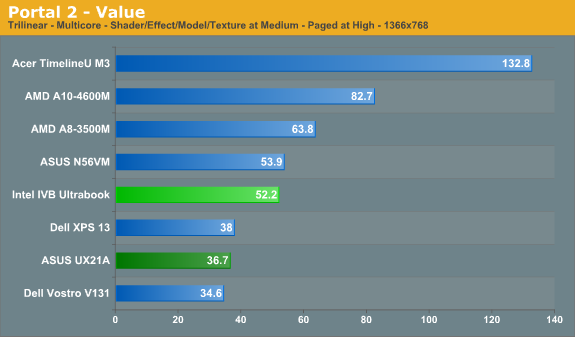
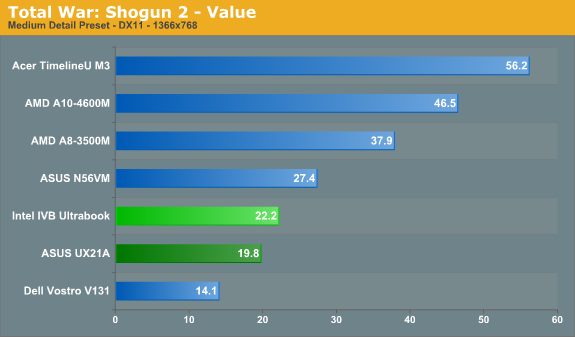
Obviously, gaming isn’t a strong suit of Ultrabooks that lack discrete graphics. The TimelineU is an Acer Ultrabook with Sandy Bridge ULV and an NVIDIA Kepler GT 640M DDR3 GPU, and it runs away from the IGP/APU-only competition in most games (Civilization V being the one exception where Trinity can close the gap). If your goal is 1366x768 gaming at medium detail settings, where the quad-core i7-3720QM manages to hit that mark in four of our seven games (five of eight if we count Diablo III—see below), it’s only in Portal 2 that ULV IVB is clearly above 30 FPS; it also basically reaches 30FPS (with periodic dips into the low 20s) in Batman, and the UX21A just barely breaks the 30FPS mark in Skyrim as well.
If you’re wondering about the score discrepancies between the IVB ULV prototype and the UX21A, Anand tested the UX21A with the currently official 2696 Intel drivers. Intel provided us with a 2725 beta driver for the prototype, and Portal 2 specifically has some performance issues fixed (and the memory leak issue we noticed in StarCraft II is also addressed).
Back on topic, ULV IVB basically isn’t going to cut it for medium detail gaming (our “Value” preset) in most titles. However, it’s a significant step up from ULV SNB if you look at the charts. We don’t have scores for the Dell XPS 13 in BF3 or TWS2, but in the other five titles the IVB upgrade is anywhere from 10% (DiRT 3) to over 40% (Civ5) faster, with most titles in the 20-35% range. Compared to a dual-core i5-2410M (Dell Vostro V131), ULV IVB isn't quite as successful, possibly because of thermal constraints. The V131 is sometimes substantially slower, but it does lead by a fair amount in Batman and Civilization V.
Unfortunately for gamers, HD 3000 Ultrabooks generally were incapable of reaching playable frame rates in most recent games, even at minimum detail settings. With the improved HD 4000 in Ivy Bridge, we decided to test our IVB Ultrabook at even lower settings just to see if dropping settings a bit more could bring the scores up; we tested at 1366x768 as well as 1600x900. We’ve also included our 1600x900 Mainstream gaming results in the following table, just in case you’re curious to see how badly IVB ULV fails at higher quality settings.
|
Ivy Bridge Ultrabook Gaming at Lower and Higher Quality Settings |
|||
|
1366x768 Minimum |
1600x900 Minimum |
1600x900 Mainstream |
|
| Batman: Arkham City | 33 | 27 | 18 |
| Battlefield 3 | 17.7 | 16.1 | 11.7 |
| Civilization V | 16.3 | 15.7 | 7.8 |
| DiRT 3 (Low) | 34.2 | 30.6 | 21 |
| Portal 2 | 53.3 | 47.8 | 25.6 |
| Skyrim | 33.7 | 29.5 | 17.5 |
| Total War: Shogun 2 | 56.4 | 47.4 | 15.1 |
At minimum/low detail settings (we didn’t drop all the way to Ultra Low in DiRT 3, though we did test that: it’s only about 1FPS faster than the Low setting), five of the seven titles reach playable frame rates. Somewhat surprisingly, most still look good as well; Skyrim and Shogun 2 at Low are probably the worst of the bunch, and they’re still tolerable. If you’re willing to drop settings this far, you can even bump the resolution up a notch in most games (assuming your Ultrabook sports a higher resolution LCD). Battlefield 3 and Civilization V on the other hand continue to be punishing on Intel hardware, and there's simply no good way to play them without an AMD or NVIDIA GPU to help out.
BF3 is a known beast, so that’s no surprise, but Civ5 has always been a sticking point for Intel and so we asked for some clarification on why performance in that title is so bad. The basic summary is that Civ5 tends to draw lots of very small objects, particularly in the LateGameView benchmark, and it doesn’t use instancing. We previously thought that the problem might be with geometry throughput on HD 3000/4000, but it looks like it might be more of a driver overhead issue that hits Intel harder than others. We’ve seen this problem with Civ5 before with relatively low frame rates even on high-end desktop GPUs; NVIDIA fixed this with some driver tweaks to improve performance on command lists, while AMD didn’t really address the issue until Southern Islands. At the very least, Intel knows about the issue and we may see a future driver that will address Civ5 performance—or we may have to wait for Haswell.
Going along with our normal gaming tests, we also did a brief look at Diablo III performance on several laptops. Many pointed out that the early portions of the game aren’t as demanding as later areas where monster mobs are larger and more spell effects are present. That’s certainly true, and we’re working on a better way to test Diablo III, but it’s not ready yet. In the meantime, I decided to perform a couple lengthy (around 20 minutes) FRAPS runs from late in Act I (Normal difficulty) and show those graphs. I played through several areas at 1366x768 with all settings on Low (but “Low FX” disabled), and I did the same at 1600x900. Average frame rates were 29.5 FPS at 1366x768 and 24.2 FPS at 1600x900, and here are the detailed charts:
Generally speaking, the 5FPS advantage for the lower resolution is consistent across around 30 minutes of gaming. Diablo III—at least in the earlier going—isn’t super demanding, and it’s possible to play it at 1600x900 on the IVB ULV Ultrabook, but it was a better experience at 1366x768 where frame rates are almost always above 20, and often in the 25-30 range. The dips in the above charts very likely coincide with battles with groups of monsters, and you can expect minimum frame rates in big battles in later acts to drop even further, so I wouldn’t recommend playing a hardcore character on this sort of laptop.
Naturally, if you want a better gaming experience, there are plenty of options to choose from. Are they as small and sleek as an Ultrabook? Generally speaking, no. The closest we’ve come to seriously thin gaming laptops might be the Sony VAIO Z, but the Acer TimelineU is definitely moving in that direction. Going forward, we expect to see quite a few Ultrabooks launching with some form of NVIDIA Optimus graphics. We already know about the TimelineU M3 and the ASUS UX32A; the TimelineU is a 14” laptop with typical Acer components (e.g. low quality screen, mediocre build quality), but it has a potent GPU. ASUS is going for a better built Ultrabook with a 1080p IPS LCD on some models (though not on the $799 model), but with a slower GT 620M GPU. The GT 620M is still a step up from the previous generation GT 540M, however, with core/shader clocks of 700/1400MHz, so it should provide for decent gaming. We’ll report more when we have a test unit in hand.
Update: If you're interested in further details on graphics performance and why the Ivy Bridge Ultrabook is quite a bit slower than the quad-core notebook, despite relatively close max iGPU clocks, we've posted a follow up article investigating real-time Ivy Bridge iGPU and CPU clocks while running games.


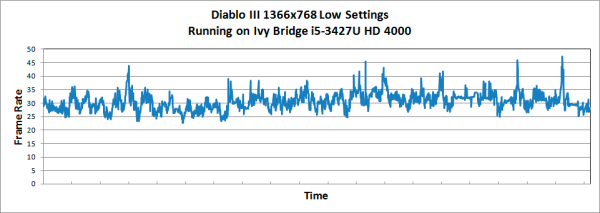
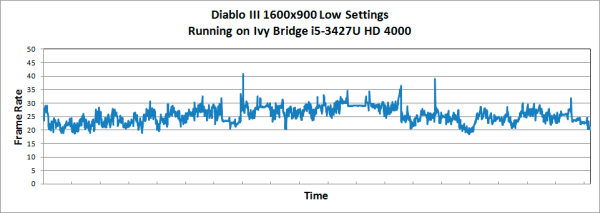








64 Comments
View All Comments
Ryan Smith - Thursday, May 31, 2012 - link
Price.ZeDestructor - Thursday, May 31, 2012 - link
And what's the difference in price? I shouldn't think its that much a big difference in between the two compared to, say, the CPU cost...JarredWalton - Thursday, May 31, 2012 - link
The chart we put together didn't include this information, but QS77 is targeted at SFF systems, so it has slightly lower power characteristics and it comes in a 22x22mm package instead of the 25x25mm packaging used on the other chipsets. Interestingly, even UM77 is 25x25mm, and that seems like the perfect chipset to have a smaller footprint.JarredWalton - Thursday, May 31, 2012 - link
Oh, nevermind: it's there. You just need to look for it.ZeDestructor - Thursday, May 31, 2012 - link
Still no price info though, I had to go Google it up :(QS77 is USD53 vs QM77 which is USD48.
To me eating 5$ worth of profit to gain some battery life is worth it, and also allows for smaller board designs. Once you factor in economies of scale, I don't see why the QS77 can't lose at least a further USD2 if the QM77 is cut out entirely and become even better value.
Source: http://laptoport.com/2011/12/28/intel-will-unveil-...
Its a good chart, just needs a price line ;)
JarredWalton - Thursday, May 31, 2012 - link
Intel didn't release pricing information, so I'd have to go to other sources to see what Intel has said in the past. Of course, it's basically meaningless to talk about chipset prices as the only people buying chipsets are the OEMs and motherboard manufacturers. Sadly, those are the same folks that will save $10 in most cases to ship a crappy LCD in place of something much better.thunderising - Thursday, May 31, 2012 - link
Wow, even with HD4000, IVB dual cores perform terribly in games.And even now, I'm pretty sure these are priced wayy above the old and new Llano Parts.
I give my vote to AMD's Trinity this round
JarredWalton - Thursday, May 31, 2012 - link
Don't jump ahead of the data: Dual-core Ivy Bridge ULV parts have generally weak performance in graphics. In a 17W TDP, it's very likely the maximum GPU clocks are not coming anywhere near 1150MHz on some titles. I suspect the standard voltage parts will be withing 5-10% of the quad-core parts for HD 4000 performance.As for AMD, their ULV/LV parts take some major GPU performance cuts as well. The A10-4655M will have GPU clocks that are 30% lower than the A10-4600M, while the A6-4455M has lower clocks and half as many Radeon cores. Given how far the A6 is cut back to fit in a 17W TDP, I don't expect it to fare much better on games.
ananduser - Thursday, May 31, 2012 - link
Well let's wait for a review first shall we ? :)JarredWalton - Thursday, May 31, 2012 - link
Sure, before we make any final statements, but based on the clocks and core counts we can certainly make a pretty good guess of where Trinity will rank with LV/ULV configurations. It's sort of like Brazos in that aspect, which is to say cutting the GPU or CPU down that far isn't going to help performance. On the compute side, though, funny things happen and compute doesn't always scale directly with core counts and clock speeds. Heck, look at the i5-3470 review from Anand: HD 2500 is sometimes 1/3 the performance of HD 4000. Ouch.Anyway, let's make some wagers. My guess on A6-4455M is that it will be about half as fast as the A10-4600M in games, while delivering about 80% of the single-threaded performance and less than half of the multi-threaded performance. The A10-4655M should do better, but it will probably still be 20-25% slower than A10-4600M for games, maybe 90% of the single-threaded performance, and 80% of the multi-threaded performance.